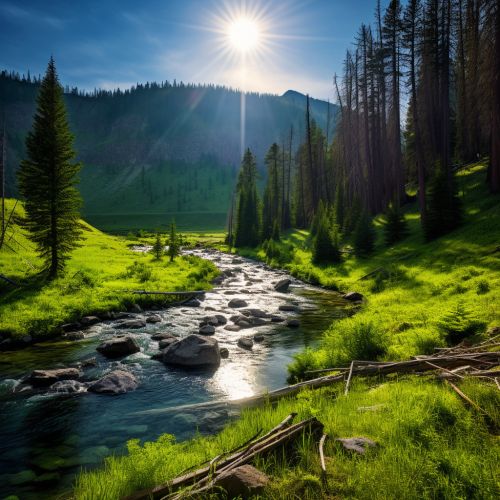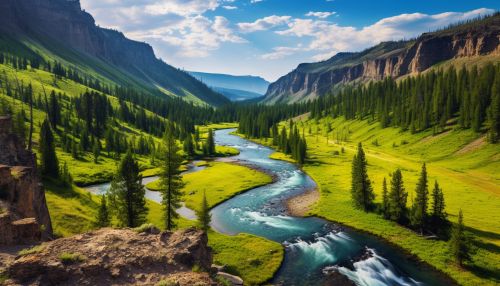Protected area
Definition and Overview
A protected area is a clearly defined geographical space, recognized, dedicated, and managed, through legal or other effective means, to achieve the long-term conservation of nature with associated ecosystem services and cultural values. The International Union for Conservation of Nature (IUCN) and its World Commission on Protected Areas has defined its categories of protected areas to help in the planning, establishment, and management of the protective zones.
History
The concept of protected areas has a long history, dating back to ancient cultures. The earliest recorded protected areas were the sacred groves of India and the royal preserves of Persia. In the modern era, the idea of setting aside areas for the protection of nature began in the United States with the establishment of Yellowstone National Park in 1872. This marked the beginning of a global movement to conserve natural habitats and the wildlife within them.


IUCN Classification
The IUCN has classified protected areas into six categories based on their management objectives. These include:
- Strict Nature Reserve (Ia): These areas are strictly protected for biodiversity and also possibly geological/geomorphical features. They are usually not open to visitors.
- Wilderness Area (Ib): These are large unoccupied areas, retained in their natural state and protected against most human activities.
- National Park (II): These are natural areas set aside to protect large-scale ecological processes along with the complement of species and ecosystems characteristic of the area. They also provide a foundation for environmentally and culturally compatible, spiritual, scientific, educational, and recreational visitor opportunities.
- Natural Monument or Feature (III): These are set aside to protect a specific natural monument, which can be a landform, sea mount, submarine cavern, geological feature such as a cave, or even a living feature such as an ancient grove.
- Habitat/Species Management Area (IV): These areas aim to protect particular species or habitats, and management reflects this priority. Many will need regular, active interventions to address the requirements of particular species or to maintain habitats.
- Protected Landscape/Seascape (V): This involves the safeguarding of an area of interacting activities between people and nature to protect both the biodiversity and the cultural values.
- Protected area with sustainable use of natural resources (VI): These areas conserve ecosystems and habitats together with associated cultural values and traditional natural resource management systems.
Benefits of Protected Areas
Protected areas offer numerous benefits, both directly and indirectly. They play a crucial role in conserving biodiversity by providing habitats for species and maintaining ecological processes that might not survive in most intensely managed landscapes and seascapes. They also serve as benchmarks against which we can measure changes in the environment elsewhere.
Protected areas often form the core of larger landscapes and seascapes that are managed in ways that maintain biodiversity. They help to prevent the extinction of species and make significant contributions to the maintenance of the earth's life support systems, from stabilizing soils and climate to purifying water.
Protected areas also contribute to people's livelihoods, particularly at the local level. They provide food and water, wood, biodiversity, carbon storage, tourism opportunities, and health benefits, both physical and mental. They are often of spiritual, archaeological, or cultural importance, and maintaining these significant sites is another key reason for their protection.
Challenges
Despite their importance, protected areas face numerous challenges. These include legal and institutional weaknesses, lack of financial and human resources, and threats from pollution, climate change, and invasive species. In many cases, protected areas are isolated fragments, surrounded by drastically altered landscapes or seascapes. This isolation can make it difficult for species to migrate or move to new locations, as their habitat conditions change.
Another significant challenge is balancing the needs and desires of local communities with the goal of conservation. In many parts of the world, people live in or near protected areas and depend on the resources they provide. These communities can feel the effects of restrictions on resource use, and conflicts can arise if these restrictions are not managed sensitively and inclusively.
Future of Protected Areas
The future of protected areas lies in recognizing their value, addressing the challenges they face, and ensuring they are managed effectively. This will likely involve a combination of strategies, including strengthening legal and institutional frameworks, increasing financial and human resources, integrating protected areas into wider land and seascapes, and working closely with local communities to manage resources sustainably.
As the impacts of climate change become more apparent, the role of protected areas in mitigating and adapting to these changes will become increasingly important. This will involve protecting and restoring ecosystems, which can absorb and store carbon, and helping species to move to more suitable locations as conditions change.
